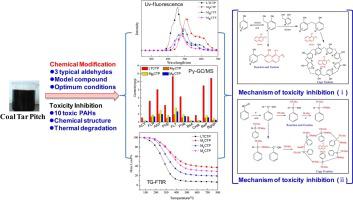当前位置:
X-MOL 学术
›
J. Anal. Appl. Pyrol.
›
论文详情
Our official English website, www.x-mol.net, welcomes your
feedback! (Note: you will need to create a separate account there.)
Chemical modification with aldehydes on the reduction of toxic PAHs derived from low temperature coal tar pitch
Journal of Analytical and Applied Pyrolysis ( IF 5.8 ) Pub Date : 2020-06-01 , DOI: 10.1016/j.jaap.2020.104822 Ming Sun , Linyang Wang , Jiaojiao Zhong , Qiuxiang Yao , Huiyong Chen , Linyu Jiao , Qingqing Hao , Xiaoxun Ma
Journal of Analytical and Applied Pyrolysis ( IF 5.8 ) Pub Date : 2020-06-01 , DOI: 10.1016/j.jaap.2020.104822 Ming Sun , Linyang Wang , Jiaojiao Zhong , Qiuxiang Yao , Huiyong Chen , Linyu Jiao , Qingqing Hao , Xiaoxun Ma

|
Abstract Low temperature coal tar pitch (LTCTP) and a model compound of pyrene were modified by formaldehyde (F), benzaldehyde (B) and furfural (K). The effects of the types and amounts of modifiers, the amount of catalyst, the reaction time and reaction temperature on the release of toxic polycyclic aromatic hydrocarbons (TPAHs) during the thermochemical degradation of LTCTP were investigated. The structures of modified LTCTPs were confirmed by FTIR, GPC and Uv-fluorescence, and the escape evaluation of TPAHs was examined by Py-GC/MS and TG-FTIR. The results of the analyses of FTIR, GPC and Uv-fluorescence show that phenols and TPAHs in LTCTP have polymerized with aldehydes to form phenolic resins and polycyclic aromatic hydrocarbon resins, respectively. The reduction rates of TPAHs released from formaldehyde modified LTCTP (MFCTP), benzaldehyde modified LTCTP (MBCTP) and furfural modified LTCTP (MKCTP) under the optimum conditions reach up to 84.01 %, 74.21 % and 81.18 % respectively. The order of carbon residue rates is as follows: MFCTP > MKCTP > MBCTP > LTCTP. Based on the above analysis, TPAHs can polymerize with themselves and phenols in LTCTP to achieve the toxicity inhibition. In addition, TPAHs may be wrapped in the “cage” of phenolic resins and polycyclic aromatic hydrocarbon resins.
中文翻译:

醛类化学改性减少来自低温煤焦油沥青的有毒多环芳烃
摘要 采用甲醛(F)、苯甲醛(B)和糠醛(K)对低温煤焦油沥青(LTCTP)和芘模型化合物进行改性。研究了改性剂的种类和用量、催化剂用量、反应时间和反应温度对LTCTP热化学降解过程中有毒多环芳烃(TPAHs)释放的影响。修饰后的 LTCTPs 的结构通过 FTIR、GPC 和 Uv 荧光证实,TPAHs 的逃逸评价通过 Py-GC/MS 和 TG-FTIR 进行检查。FTIR、GPC和紫外荧光分析结果表明,LTCTP中的酚类和TPAHs分别与醛类聚合形成酚醛树脂和多环芳烃树脂。甲醛改性LTCTP(MFCTP)释放的TPAHs的减少率,最佳条件下的苯甲醛改性LTCTP(MBCTP)和糠醛改性LTCTP(MKCTP)分别达到84.01%、74.21%和81.18%。残炭率顺序为:MFCTP>MKCTP>MBCTP>LTCTP。综上所述,TPAHs 可以与 LTCTP 中的自身和酚类聚合,从而达到抑制毒性的目的。此外,TPAHs可能被包裹在酚醛树脂和多环芳烃树脂的“笼子”中。
更新日期:2020-06-01
中文翻译:

醛类化学改性减少来自低温煤焦油沥青的有毒多环芳烃
摘要 采用甲醛(F)、苯甲醛(B)和糠醛(K)对低温煤焦油沥青(LTCTP)和芘模型化合物进行改性。研究了改性剂的种类和用量、催化剂用量、反应时间和反应温度对LTCTP热化学降解过程中有毒多环芳烃(TPAHs)释放的影响。修饰后的 LTCTPs 的结构通过 FTIR、GPC 和 Uv 荧光证实,TPAHs 的逃逸评价通过 Py-GC/MS 和 TG-FTIR 进行检查。FTIR、GPC和紫外荧光分析结果表明,LTCTP中的酚类和TPAHs分别与醛类聚合形成酚醛树脂和多环芳烃树脂。甲醛改性LTCTP(MFCTP)释放的TPAHs的减少率,最佳条件下的苯甲醛改性LTCTP(MBCTP)和糠醛改性LTCTP(MKCTP)分别达到84.01%、74.21%和81.18%。残炭率顺序为:MFCTP>MKCTP>MBCTP>LTCTP。综上所述,TPAHs 可以与 LTCTP 中的自身和酚类聚合,从而达到抑制毒性的目的。此外,TPAHs可能被包裹在酚醛树脂和多环芳烃树脂的“笼子”中。











































 京公网安备 11010802027423号
京公网安备 11010802027423号